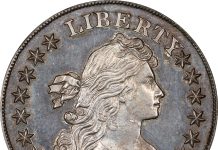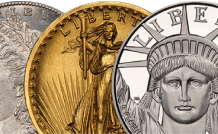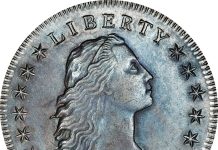40-Year Anniversary in Gold, Silver, Platinum and Palladium
By Joshua McMorrow-Hernandez
The American Eagle bullion coin program is a cornerstone of the United States numismatic collecting and investing scene. But American Eagles haven’t always been a U.S. Mint mainstay.
Forty years ago, they were mere concepts on the proverbial drawing board. Many bullion investors and collectors were building numismatic sets and precious-metals portfolios with Canadian Maple Leafs, Mexican Libertads and Chinese Pandas. Those three programs debuted during the late 1970s and early 1980s as part of a small but growing body of modern bullion coins born after the debut of the South African Krugerrand in 1967. Yet, the U.S. Mint hadn’t begun minting high-purity silver and gold coins, let alone palladium and platinum coinage, designed patently for bullion investment.
The origin story of the American Eagle traces back to the 1970s, when debates began about massive selloffs of government-stockpiled silver. The conversation continued in the corridors of Capitol Hill into the 1980s before taking a rather unexpected twist toward gold in 1985. While the success of the American Eagle program was once only the stuff of dreams, today few can imagine a world without these wildly popular bullion coins.
Selling Silver
American Eagle coins originally evolved from an effort to liquidate most of the nation’s physical silver reverses in the 1970s and early 1980s. The move was rooted in whittling down federal deficits, but not everyone was happy with the plan to sell silver to help make the nation more solvent. More than 130 million ounces of silver were stored in the Defense National Stockpile Center, a strategic reserve that houses a variety of critical raw materials such as titanium, cobalt, lithium and other resources that could be used for national defense.
Top government brass determined that selling off domestic silver was a great way to pay federal bills. But military officials preferred seeing funds from the silver sales go toward replenishing the government stockpile with other important defense materials. Meanwhile, silver mining interests out West were concerned that a flush of fresh silver into the marketplace would depress silver prices. “When the U.S. government makes noise about selling silver from the federal stockpile, futures traders start unloading futures contracts in speculation that such a sale would suppress prices,” stated a 1976 article in the Wall Street Journal.
Waiting in the wings was Ronald Reagan, who ran for president on a platform of fiscal responsibility in the 1980 election. He was inaugurated the following year, ready to slash the budget and reduce the federal deficit. He ordered the silver sales to start in fiscal year 1982, with the House and Senate approving the sale of up to 75% of the silver reserves over three years.
Coining a Better Idea
The silver selloff was to begin in October 1981, news that caused silver prices to slide 11%. This rattled nerves in places like Idaho, where silver mining was big business. Faltering silver prices prompted several Idaho politicians to protest the sale, citing “disastrous effects” on the silver industry if the silver dump moved forward as planned.
Idaho Republican Senator James A. McClure pumped the brakes on the sale via a successful rider to a Department of Defense appropriations bill. McClure’s bill halted sales “until the president, not later than July 1, 1982, redetermines that the silver authorized for disposal is excess to the requirements of the stockpile.”
With the silver selloff at bay for the moment, a conversation began on how best and most profitably to liquidate the silver. McClure and fellow Idaho Republican Larry Craig, a congressman, introduced identical bills on May 27, 1982 “to provide for the disposal of silver from the National Defense Stockpile through the issuance of silver coins.” The bills limited how much stockpiled silver would be sold and called for the bullion to occur during the calendar years of 1983, 1984 and 1985 to minimize the effect on the price of silver.
The bills brought forth by McClure and Craig never escaped committee, so McClure repackaged his 1982 proposal in a January 1983 bill. He said, “If we are forced to accept a sale, why use the method guaranteed to depress prices and dispose of silver with the lowest possible return to the taxpayers[?] Why not instead, if we must sell, at least get as much for it as we can?”
McClure’s second outing with silver coin legislation reached hearings in the Committee on Banking, Housing, and Urban Affairs on April 15, 1983. However, the bill once more failed to gain traction.
Third Time is the Charm
In 1985, McClure solidified his vision for silver bullion coinage in the Liberty Coin Act. It called for a new bullion coin to be minted “in quantities sufficient to meet public demand.” The bill provided essential specifics on what the new silver coin would look like.
The Liberty Coin Act declared the new silver bullion coin would measure 40.6 millimeters in diameter, weigh 31.103 grams, contain 0.999-fine silver, and have a design “symbolic of Liberty on the obverse side and of an eagle on the reverse side.” The proposal also directed the coins to be monetized as legal tender and sold to the “public at a price equal to the market value of the bullion at the time of sale, plus the cost of minting, marketing, and distributing such coins (including labor, materials, dyes, use of machinery, and overhead expenses).”
A Senate voice vote approved McClure’s Liberty Coin Act, which was proposed on June 21, 1985. It was attached as an amendment to the Statue of Liberty-Ellis Island Commemorative Coin Act, authorizing production of the 1986 Statue of Liberty clad half dollar, silver dollar and gold $5 coins. The House approved the bill and it was signed into law by President Reagan on July 9, 1985.
What About the Gold?
Keen observers realize something seems to be missing from the Liberty Coin Act: Where is the mention of the gold coins that would be issued under the American Eagle banner? Didn’t they debut alongside the American Silver Eagle, which was born from the Liberty Coin Act?
Going into the 1980s, the world’s most successful gold bullion coin was unquestionably the South African Krugerrand. But there was a big problem with the coin: It hailed from a nation whose government enforced apartheid, a formal system of segregation in which South Africa’s white minority used tactics of violence, economic suppression and other forms of discrimination against its non-white populations.
As Congress was considering economic sanctions against South Africa, Reagan introduced his own sanctions proposal in September 1985. Among the sanctions was a ban on imports of the Krugerrand, a coin that garnered $600 million in U.S. sales in 1984 alone.
U.S. sanctions against South Africa kicked in on October 11, 1985, forcing American investors to seek alternative forms of gold. At the time, domestic options included American Arts Commemorative Gold Medallions featuring designs of various American artists as depicted on half-ounce and one-ounce planchets. The gold medals saw decent sales after their initial release in 1980, but the annual program failed to catch on and was retired in 1984.
The absence of a domestic gold program amid the sanctions against South Africa compelled Congress to contemplate a new gold coin that could fill the gap left in the wake of the banned Krugerrand. The Gold Bullion Act of 1985 called for four gold coins in the sizes of one-tenth ounce, one-quarter ounce, one-half ounce and one ounce, and all with a fineness of .9167, or 22 karats. These specifications are identical to those of the gold coins that were produced under the Krugerrand banner. As late COINage Senior Editor Ed Reiter concluded in a piece for The New York Times, “These similarities underscore the fact that Congress intended the new coins as American alternatives to the Krugerrand.”
The Gold Bullion Act of 1985 received unanimous approval of the Senate and the House as the year wound down, with President Reagan signing the gold bullion coin program into law on December 17, 1985. But what would the new coins be called, and what would they look like?
What’s in a Name?
What started as an initiative to sell off surplus silver spun into an elaborate bullion coin program that included offerings in both silver and gold. As calendar pages turned to 1986, it was clear that the gold arm of the new bullion program was driving the overall marketing strategy for the new coins. This was in large part an outcropping of language in the Gold Bullion Act of 1985, which mandated that the Family of Eagles design by Miley Busiek (now Miley Frost) should appear on the reverse of the one-ounce coin, to be denominated as $50.
The United States Treasury ultimately implemented the Family of Eagles motif on all four of the gold denominations, lending to the “Eagles” name for the gold coins. It followed that the complementary new silver coin would also carry a similar name in keeping with the Mint’s overarching banner for the new bullion program.
“American Eagle was chosen as the coins’ official name after months of research and discussion,” Reiter wrote in a September 21, 1986 column for The New York Times. “Treasury and Mint officials had some reservations about the term, fearing that it might cause confusion between the bullion coins and traditional U.S. gold coins, whose official denominations include the double eagle, eagle, half eagle and quarter eagle. They decided that by adding the word ‘American,’ they were giving the new ‘Eagle’ a sufficiently distinctive name.”
A Patriotic Formula
The clock was ticking toward the time when the new American Eagle coins would emerge from the nest and into the world. Aims for production expediency dictated the use of existing designs for the obverses of the American Eagle gold and silver coins.
The Walking Liberty design by Adolph A. Weinman that originally appeared on the obverse of the half dollar from 1916 through 1947 was chosen for the silver coin. Mint engraver John Mercanti crafted a modern heraldic eagle device for the reverse of the Silver Eagle. Meanwhile, the majestic Liberty motif by Augustus Saint-Gaudens featured on the obverse of the $20 Gold Double Eagle from 1907 through 1933 was married with Busiek-Frost’s Family of Eagles reverse for the gold coins.
The American Eagle gold coins were initially offered for sale on October 20, 1986, with the American Eagle silver coin hitting the market on November 24. Sales of the new coins were extraordinary. The 1987 Annual Report of the Director of the Mint broke down initial sales figures. “By March 30, 1987, sales of American Eagle Gold and Silver Uncirculated Bullion coins had surpassed all projections. Final sales figures for FY87 [Fiscal Year 1987] totaled 2,659,250 ounces of gold bullion coins and 11,806,000 ounces of silver bullion coins. Gross receipts for the year totaled more than $1.1 billion in the sales of American Eagle Gold Bullion Coins and over $85.7 million in the sales of American Eagle Silver Bullion Coins.”
Bullion strikes were distributed into the marketplace through a network of Mint-authorized purchasers. The bullion coins were accompanied by proofs sold directly to the public. In the years since, other product options joined the American Eagle family of coins, with the Silver and Gold Eagles now available in a variety of numismatic finishes, and platinum and palladium coins also among the offerings. In 2021, the reverses of the American Eagle gold and silver coins were replaced by new designs. The American Silver Eagle now carries a visage of a bald eagle carrying an olive branch as designed by Emily S. Damstra and sculpted by Michael Gaudioso. The American Gold Eagle features a reverse by Jennie Norris and sculpted by Renata Gordon that closes in on the head of an eagle.
As American Eagles reach their 40th anniversary they maintain their dominance as the most popular bullion coins in the world. The future looks truly golden for the American Eagle program as it enters its fifth decade of production.












